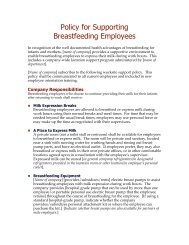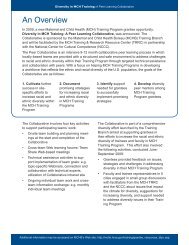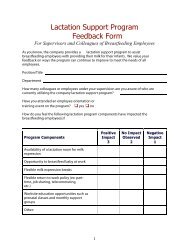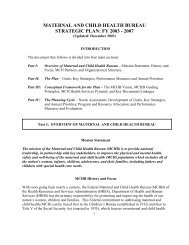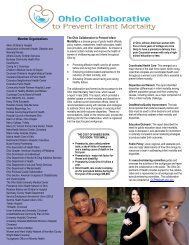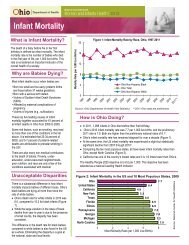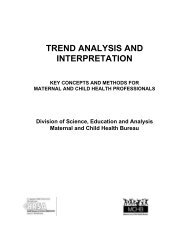improving infant mortality in ohio - Maternal and Child Health ...
improving infant mortality in ohio - Maternal and Child Health ...
improving infant mortality in ohio - Maternal and Child Health ...
You also want an ePaper? Increase the reach of your titles
YUMPU automatically turns print PDFs into web optimized ePapers that Google loves.
(The follow<strong>in</strong>g explanation was taken from a plann<strong>in</strong>g grant submitted to Kelloggfoundation by Dr. Michael Lu (Mario Drummond, Magda Peck, Cheri Pies,Milton Kotelchuck) on 5/12/2010 for consideration of establish<strong>in</strong>g BBZ). Thisconcept hosted it’s <strong>in</strong>augural meet<strong>in</strong>g <strong>in</strong> New Orleans, Louisiana dur<strong>in</strong>g the weekof 7/16/2012 <strong>and</strong> is launch<strong>in</strong>g <strong>in</strong> four cities (C<strong>in</strong>c<strong>in</strong>nati, Ohio; Milwaukee,Wiscons<strong>in</strong>; New Orleans, Louisiana; <strong>and</strong> a city <strong>in</strong> northern California)a. Goal: To elim<strong>in</strong>ate disparities <strong>in</strong> child <strong>and</strong> family healthb. Objective: Establish (10) Kellogg Best Babies Zones (BBZs), with the first<strong>and</strong> primary objective of clos<strong>in</strong>g the <strong><strong>in</strong>fant</strong> <strong>mortality</strong> gap <strong>in</strong> participat<strong>in</strong>gcommunities <strong>in</strong> 10 years.c. Background: Despite advancements <strong>in</strong> cl<strong>in</strong>ical medic<strong>in</strong>e <strong>and</strong> public health,racial-ethnic <strong>and</strong> socioeconomic disparities <strong>in</strong> child <strong>and</strong> family health persist.A new, bold, transformative approach is needed. Our system of care is fragmented at best; we spend more <strong>in</strong> the U.S.but achieve less The racial-ethnic <strong>and</strong> socio-economic <strong>in</strong>equities <strong>in</strong> health are mirrored<strong>in</strong> the <strong>in</strong>equities <strong>in</strong> the conditions <strong>and</strong> environments <strong>in</strong> which peoplelive We must take health promotion beyond cl<strong>in</strong>ical care While the first <strong>and</strong> primary objective of the BBZ is to close the <strong><strong>in</strong>fant</strong><strong>mortality</strong> gap <strong>in</strong> 10 years, BBZ is also designed to close the gaps <strong>in</strong>child obesity, asthma, developmental delays, etc. because the same<strong>in</strong>equities that create the <strong><strong>in</strong>fant</strong> <strong>mortality</strong> gap also contribute todisparities <strong>in</strong> child <strong>and</strong> family health. The health gap <strong>in</strong> MCH is an underappreciated contributor to theachievement gap <strong>in</strong> schools that is a cause of poor productivity, higherrate of poverty <strong>and</strong> other national <strong>and</strong> social ills; clos<strong>in</strong>g the health gap<strong>in</strong> MCH is an important prerequisite to clos<strong>in</strong>g the achievement gapd. Approach: Multi-level, multi-sectoral, <strong>and</strong> life-course Multi-level: not only <strong>in</strong>dividual, but family, community, systems, <strong>and</strong>policy Multi-sectoral: not only health development, but educational,economic, <strong>and</strong> community development Life-course: not only disease prevention, but health promotion <strong>and</strong>optimization over the life course, with strategic <strong>in</strong>vestments <strong>in</strong>sensitive periods. We are creat<strong>in</strong>g “pipel<strong>in</strong>es” to health.e. Conceptual Frameworks Ecological model <strong>and</strong> social determ<strong>in</strong>ants <strong>Health</strong> Equity Life-course health development



